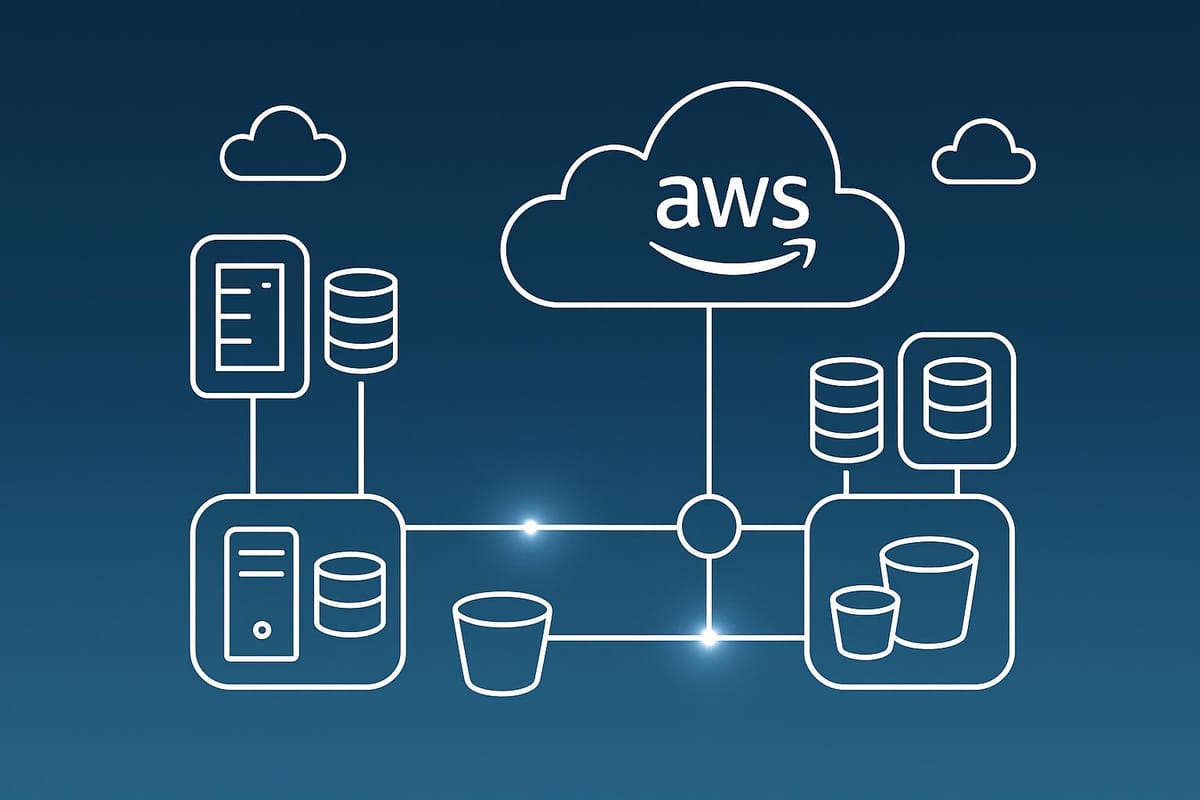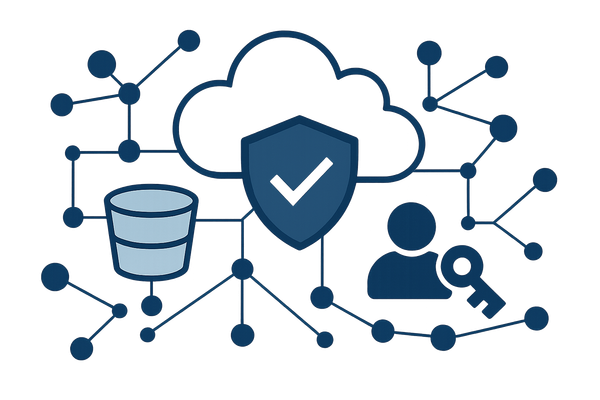Ultimate Guide to Multi-Region AWS Architectures
Explore the essentials of multi-region AWS architectures, focusing on benefits, design patterns, cost management, and compliance for UK SMBs.

Want to ensure your applications are always available, even during outages? Multi-region AWS architectures can help. Here's what you need to know:
- What It Is: Multi-region AWS architecture involves deploying applications across multiple AWS regions to improve fault tolerance, reduce latency, and enhance availability.
- Why It Matters: It ensures uninterrupted service, improves user experience by reducing latency, and helps meet global data compliance requirements like GDPR.
- Key Benefits for UK SMBs:
- Faster response times for global users.
- Business continuity during regional outages.
- Compliance with UK and EU data regulations.
- Challenges to Consider:
- Higher costs and budget constraints.
- Need for specialised expertise.
- Managing complexity and Brexit-related data flow regulations.
- Design Patterns:
- Active-Active: High resilience, immediate failover, but costly and complex.
- Active-Passive (Warm Standby or Pilot Light): Balances cost and recovery speed.
- Backup & Restore: Low cost but slower recovery times.
- AWS Tools to Simplify Setup:
- Route 53 for traffic management.
- S3 Cross-Region Replication for data backup.
- CloudWatch for monitoring.
Quick Comparison of Design Patterns:
| Pattern | Cost | Complexity | Failover Speed | Best For |
|---|---|---|---|---|
| Active-Active | High | High | Immediate | Mission-critical global applications |
| Warm Standby | Medium-High | Medium | Minutes | Key apps needing fast recovery |
| Pilot Light | Medium | Medium-Low | 10–30 minutes | Cost-conscious disaster recovery |
| Backup & Restore | Low | Low | Hours to days | Non-critical apps or data archiving |
Start small with a Pilot Light or Warm Standby setup and scale as your business grows. For UK SMBs, prioritise cost-efficient solutions and compliance with local regulations. Multi-region architectures are a powerful way to boost reliability and performance while safeguarding user trust.
Multi-Region Design Patterns
Main Design Pattern Types
When it comes to multi-region design, SMBs have several tried-and-tested patterns to choose from. Each has its own balance of complexity, cost, and resilience.
Active-Active setups are the most resilient but also the most complex. In this configuration, all regions serve traffic simultaneously, distributing the load across multiple locations. This approach boasts the lowest Recovery Time Objective (RTO) and Recovery Point Objective (RPO). However, it demands robust traffic routing, data synchronisation, and conflict resolution mechanisms.
Active-Passive configurations designate one region as the primary, with another on standby for disaster recovery. Two common variations include the Pilot Light pattern, which keeps critical systems ready for rapid activation, and Warm Standby, which maintains a scaled-down version of the production environment for quicker failover.
Backup and Restore is the simplest option. It involves regularly backing up data and configurations to another region. While this approach is cost-effective, it results in the longest recovery times, making it suitable only for less critical applications.
AWS services like Amazon Aurora Global Database illustrate how these patterns can be implemented effectively. Aurora can replicate data to secondary regions with latencies typically under a second. In the event of a primary region failure, a secondary region can take over read/write operations in under a minute - even during a full regional outage.
Understanding these patterns sets the stage for evaluating their trade-offs.
Comparing Design Pattern Trade-Offs
| Pattern | Cost | Complexity | Failover Speed | Best For |
|---|---|---|---|---|
| Active-Active | High | High | Immediate | Mission-critical apps with global users |
| Warm Standby | Medium-High | Medium | Minutes | Key apps needing fast recovery |
| Pilot Light | Medium | Medium-Low | 10–30 minutes | Cost-conscious SMBs with moderate RTO |
| Backup & Restore | Low | Low | Hours to days | Non-critical apps and data archiving |
Active-Active offers the best user experience and availability but comes with steep challenges. Managing data consistency across regions, implementing complex routing logic, and doubling infrastructure costs are some of the hurdles. For a more balanced approach, Active-Passive patterns are cost-effective but come at the expense of lower availability and scalability.
The Pilot Light pattern demands thorough planning for startup processes. Automation is key to scaling infrastructure and launching application servers during failover, keeping costs manageable. While it involves "turning on" servers when needed, Warm Standby is partially deployed and only requires scaling up further.
For faster recovery at a higher cost, Warm Standby is a strong choice. AWS suggests that if your organisation can support a fully deployed secondary environment, Active-Active might be worth considering. However, for those preferring not to manage traffic across multiple regions simultaneously, Warm Standby offers a simpler, more economical alternative.
Choosing the Right Pattern for SMBs
Choosing the right multi-region design pattern depends on your business requirements, technical capabilities, and budget. A practical strategy is to start with a simpler architecture and expand as your business grows.
For many SMBs in the UK, starting with a Pilot Light or Warm Standby setup is a sensible choice. These options deliver solid disaster recovery without the operational challenges of an Active-Active design. The decision between the two depends on your recovery time needs and financial resources. For example, applications with heavy write operations may face challenges with conflict resolution in Active-Active setups, whereas read-heavy applications can leverage the benefits of traffic distribution across regions.
Efforts should focus on customer-facing systems that directly influence revenue. Internal tools or development environments often don't justify the added complexity and cost.
Some global businesses adopt strategies like a hub-and-spoke model or a "follow the sun" approach, aligning regions with time zones for optimal performance.
Operational readiness is another critical factor. This includes ensuring service quotas are consistent across regions, setting up region-specific IAM permissions, and configuring appropriate service control policies. Overlooking these details can lead to failed disaster recovery attempts.
"A complex system that works is invariably found to have evolved from a simple system that worked. The inverse proposition also appears to be true: A complex system designed from scratch never works and cannot be made to work. You have to start over, beginning with a working simple system."
Start with a basic disaster recovery plan, such as Pilot Light or Warm Standby, and evolve to more advanced setups as your team gains expertise.
For more guidance on balancing cost, performance, and resilience in multi-region AWS architectures - and to discover actionable cost-saving strategies tailored for SMBs - visit AWS Optimization Tips, Costs & Best Practices for Small and Medium sized businesses.
This foundation prepares you for deeper discussions on AWS tools and cost management.
AWS re:Invent 2024 - Best practices for creating multi-Region architectures on AWS (ARC323)
AWS Services and Tools for Multi-Region Setup
Creating a multi-region architecture involves selecting AWS services that come with built-in multi-region capabilities. By choosing services designed for this purpose, you can simplify the process and reduce operational complexity.
Core AWS Services for Multi-Region
DNS and Traffic Management is a critical starting point for any multi-region setup. Amazon Route 53 handles DNS and supports both latency-based and geo-location routing. Its Application Recovery Controller (ARC) enhances disaster recovery by rerouting traffic between regions during outages. For UK small and medium-sized businesses (SMBs) serving customers across Europe, latency-based routing ensures users are directed to the fastest available region.
Global Networking connects your regions seamlessly. AWS Global Accelerator provides static anycast IP addresses, offering a single entry point for your applications. If a regional endpoint becomes unavailable, traffic is automatically redirected to healthy endpoints without requiring DNS updates.
Data Replication keeps your data synchronised across regions, improving both performance and compliance. For instance, S3 Cross-Region Replication (CRR) transfers objects between S3 buckets in different regions. A UK-based business with a data warehouse on AWS S3 can use this feature to duplicate data for disaster recovery. For databases, Amazon DynamoDB Global Tables offer multi-region, multi-writer functionality, while Amazon Aurora Global Database supports read scaling across regions.
Security and Compliance tools ensure consistent protection and performance across regions. AWS Identity and Access Management (IAM) works in all regions, providing uniform authentication and authorisation. AWS Key Management Service (KMS) offers multi-region keys to replicate key material securely. Additionally, AWS Security Hub consolidates security findings from multiple regions into one dashboard, simplifying compliance for UK businesses navigating GDPR.
Compute and Application Services provide multi-region capabilities to streamline operations. Amazon EC2 Global View offers a centralised dashboard for monitoring EC2 resources across regions. EC2 Image Builder simplifies the creation and replication of AMIs to other regions. For containerised applications, Amazon Elastic Container Registry (ECR) ensures consistent container image availability through private image replication.
These services lay the groundwork for automation and monitoring, which are explored in the following section.
Automation and Monitoring Tools
Infrastructure as Code is indispensable for managing resources across regions. AWS CloudFormation allows you to define your infrastructure in templates that can be deployed consistently. Start with pre-built templates and customise them as needed. Enable CloudTrail logging and set up Amazon SNS notifications to monitor CloudFormation events across regions.
Serverless Automation with AWS Lambda simplifies routine tasks. For SMBs, starting small with Lambda functions is a practical approach. Use provisioned concurrency for low-latency operations and enable logging to monitor performance. Secure access across regions using well-defined IAM roles.
| Tool | Key Benefit | Cost Consideration |
|---|---|---|
| AWS Lambda | Automates tasks without servers | Pay-as-you-go, free tier available |
| AWS Elastic Beanstalk | Fast app deployment and management | No extra fees beyond AWS resources |
| AWS Systems Manager | Central IT management | Free with AWS resource usage |
| AWS CloudFormation | Infrastructure as code | Free tool, pay for provisioned resources |
| AWS Step Functions | Workflow automation | Free tier for limited transitions |
Workflow Orchestration is handled effectively with AWS Step Functions, which coordinate complex tasks across regions. Choose between Standard workflows for long-running processes or Express workflows for high-volume, short-duration tasks. Use intrinsic ASL functions for efficient data management.
Comprehensive Monitoring is made possible with Amazon CloudWatch, which tracks performance metrics across all regions. Set up dashboards to view key metrics from multiple regions in one place. AWS CloudTrail logs API activity, which is invaluable for compliance and troubleshooting.
Backup Automation is straightforward with AWS Backup. This service centralises and automates data protection across regions. Amazon Data Lifecycle Manager further simplifies EBS snapshot creation and cross-region copying, ensuring your data is protected without manual effort.
Using these tools helps streamline operations while keeping costs and performance in check - essential for SMBs managing multi-region setups.
SMB Implementation Tips
Start with Built-In Capabilities when designing multi-region applications. AWS services with native multi-region features minimise complexity and operational overhead. For existing applications, evaluate your current architecture to determine how best to scale.
Focus on Customer-Facing Systems that directly impact revenue. Internal tools and development environments often don’t justify the added complexity and cost of multi-region deployment. Prioritise areas that deliver the most value to your business.
Optimise Costs from the Beginning instead of addressing it later. Reserved Instances and Savings Plans can significantly lower costs across regions. Use Lifecycle Policies for S3, ECR, and EBS snapshots to manage storage expenses. S3 Intelligent-Tiering, for example, can reduce storage costs by 40% to 95% by automatically moving data to the most cost-effective access tier.
"AWS cost optimisation is not a one-time activity but a continuous process requiring diligence, strategic planning, and adaptability." – Fedir Kompaniiets, DevOps and Cloud Architecture Expert, Co-founder of Gart
Leverage ARM-Based Graviton Processors to potentially save up to 30% on costs. Spot Instances are another cost-saving option, offering discounts of up to 90% for workloads that can tolerate interruptions.
Use VPC Endpoints to cut data transfer costs between AWS services in multi-region deployments. Interface or Gateway Endpoints for services like S3, SQS, and DynamoDB help keep traffic within AWS’s network, avoiding extra internet gateway charges.
Monitor Costs Regularly with AWS Cost Explorer and budget alerts. Cost allocation tags can help track spending across regions and projects. Public IPv4 addresses now cost around £0.004 per IP address per hour, so careful planning can further optimise networking expenses.
Mastering these services and tools is essential for building a robust multi-region architecture while keeping performance and costs under control.
Performance Optimisation Across Regions
Ensuring smooth performance across regions is all about balancing speed and cost. For UK small and medium-sized businesses (SMBs), this means creating systems that deliver quick response times without overspending. Multi-region architectures play a key role here, but they require careful planning, particularly around traffic management and performance tracking.
Managing Latency and Traffic Routing
When it comes to multi-region systems, traffic routing is the foundation of good performance. Tools like AWS Global Accelerator use static anycast IP addresses to route traffic through AWS's global network, which can improve performance by up to 60%.
To complement this, Amazon Route 53 offers latency-based routing. This feature ensures users are directed to the region with the lowest latency. For instance, users in Manchester are automatically connected to the eu-west-2 (London) region, while those in Frankfurt are routed to eu-central-1. This happens seamlessly, without the need for manual adjustments.
Resource placement also plays a big role in optimising performance. AWS Local Zones bring compute and storage closer to end users, making real-time applications more responsive with millisecond-level latency. For tasks requiring high-performance computing, Cluster Placement Groups deliver ultra-low latency between instances within the same availability zone.
| Placement Type | Best Use Case | Latency Impact |
|---|---|---|
| Availability Zones | High-availability applications | Low inter-zone latency |
| Local Zones | Real-time applications | Very low latency to end users |
| Cluster Placement Groups | High-performance computing | Ultra-low instance-to-instance latency |
Network choices further influence performance. AWS Direct Connect provides dedicated, private connections with consistent sub-millisecond latency. While it comes with port charges, it offers more reliability compared to internet-based connections - especially for data-heavy applications.
Choosing between Global Accelerator and CloudFront depends on your needs. Global Accelerator is ideal for applications requiring static IP addresses or instant failover between regions. CloudFront, on the other hand, excels at delivering both cached and dynamic content through edge locations. Plus, CloudFront includes 1TB of free data transfer, making it a cost-friendly option for content distribution.
These routing and placement strategies create a solid foundation for monitoring performance in multi-region environments.
Key Metrics and Monitoring
Monitoring multi-region systems requires a different approach compared to single-region setups. AWS CloudWatch operates regionally, meaning you need to set up alarms in every region where your application runs. This ensures visibility even if one region experiences an issue.
Replication lag monitoring becomes critical in multi-region deployments. Delays in synchronising data between regions can affect application performance, a challenge that doesn't exist in single-region setups.
AWS Network Manager adds another layer of insight with real-time data on inter-region, inter-availability zone, and intra-availability zone latency. It also tracks the health of AWS's global network, storing metrics for up to 45 days for historical analysis.
| Monitoring Type | Tool | Key Metrics | Alert Triggers |
|---|---|---|---|
| Network Flow | CloudWatch Flow Monitor | Packet loss, latency | Custom thresholds |
| Internet Performance | CloudWatch Internet Monitor | End-user experience, traffic | Performance degradation |
| Infrastructure | Network Manager | Inter-region, inter-AZ latency | Pre-set thresholds |
Customer experience monitoring is equally important. Health checks and synthetic tests (canaries) from standby regions can provide an external view of your primary region's performance. This becomes especially useful during incidents when visibility into the primary region might be limited.
CloudWatch Synthetics enables proactive monitoring by simulating user behaviour with configurable scripts. These tests help spot potential issues before they impact actual users.
To simplify the complexity of multi-region monitoring, centralised observability is essential. By using a dedicated monitoring account, you can aggregate data from all regions, streamlining security and compliance management while reducing false alarms.
Cost vs Performance Balance
Balancing costs and performance is a key challenge for SMBs. Regional pricing variations can offer savings, but careful analysis is needed to identify the most cost-effective combinations.
Using AWS's private infrastructure, such as Global Accelerator and Direct Connect, can significantly reduce latency - up to 60% - but costs vary depending on the number of accelerators and data transfer volumes.
| Service Type | Performance Benefit | Cost Impact | Best For |
|---|---|---|---|
| Gateway Endpoints | Reduced latency for S3/DynamoDB | No additional cost | Basic optimisation |
| CloudFront | Faster content delivery | First 1TB free, tiered pricing | Content distribution |
| Direct Connect | Consistent low latency | Fixed port charges, lower data costs | High-volume data transfer |
Serverless architectures offer another way to manage costs. With a pay-as-you-go model, you only pay for what you use, which is ideal for SMBs with fluctuating workloads. This approach also ensures high availability and scalability across multiple availability zones.
Auto Scaling is another cost-efficient tool. It adjusts resources based on demand, helping you save during quiet periods while maintaining performance during peak times. For consistent workloads, combining Auto Scaling with Reserved Instances can further reduce costs.
VPC Endpoints, like Gateway Endpoints for S3 and DynamoDB, eliminate internal traffic costs without any additional charges, making them a straightforward choice for basic optimisation.
Regular cost reviews using AWS Cost Explorer and Trusted Advisor can uncover new opportunities for savings. The AWS Optimization Tips, Costs & Best Practices for Small and Medium sized businesses blog offers practical advice tailored for SMBs navigating multi-region deployments.
While optimising performance across regions enhances user experience, it also directly affects operational costs. Monitoring these costs is just as important as tracking performance metrics. For example, CloudWatch metrics for network performance monitoring incur charges for each inter-region or inter-availability zone metric published. However, the insights gained often justify the expense by improving incident response and capacity planning.
Implementation Guidelines, Costs, and Compliance
Setting up multi-region AWS architectures requires careful planning across technical execution, cost management, and compliance with regulations. For UK small and medium-sized businesses (SMBs), these factors are especially important as they aim to balance performance, cost-efficiency, and strict data protection standards.
Multi-Region Implementation Guidelines
A successful multi-region setup begins with thoughtful assessment and planning. Start by evaluating your application's user base, regulatory requirements, and availability goals. For instance, global companies often rely on active-active deployments and rigorous failure testing to ensure resilience.
When choosing regions, prioritise areas with high user density to reduce latency while adhering to data residency laws. For UK businesses, the eu-west-2 (London) region is commonly the first choice, with eu-west-1 (Ireland) or eu-central-1 (Frankfurt) serving as secondary options for broader European coverage.
To maintain consistency and minimise errors, use Infrastructure as Code (IaC) tools like AWS CloudFormation or Terraform. These tools ensure that disaster recovery setups mirror production environments.
Automating scaling and recovery processes is essential. Regularly test disaster recovery by simulating failures and refining recovery times.
"Mastering multi-region architectures on AWS amounts to more than a simple technical implementation. It is a state of mind directed at everything resilient, scalable, and delivering an outstanding user experience."
For monitoring, remember that AWS CloudWatch operates regionally. Set up monitoring in each region where your application runs to maintain consistent performance and availability. Once the technical foundation is solid, the next step is managing costs effectively.
Cost Management for Multi-Region Setup
Running multi-region deployments can increase costs, so UK SMBs need to manage expenses carefully. Regional pricing differences can significantly impact budgets, with US regions often offering lower service costs.
Data transfer expenses are another key factor. Cross-region transfers are more expensive than intra-region ones. To optimise costs, consider strategies like:
- Reserved Instances and Savings Plans: These can reduce costs by up to 72% compared to on-demand pricing for predictable workloads.
- Right-sizing resources: Avoid overprovisioning by matching resources to actual demand.
- Auto Scaling: Dynamically adjusts capacity based on usage.
Tools like AWS Cost Explorer provide detailed spending insights, helping identify cost-effective regions and availability zones. Setting up billing alerts can also prevent unexpected charges.
For businesses with variable workloads, serverless architectures like AWS Lambda can be a cost-effective choice. These services operate on a pay-as-you-go model, charging only for the compute time used.
Storage costs can also be optimised through data lifecycle management. For example, S3 Intelligent-Tiering automatically moves data between access tiers based on usage, while infrequently accessed data can be archived to S3 Glacier or S3 Deep Archive for long-term savings.
These strategies not only help control costs but also support the scalability and resilience required for multi-region deployments. For more tips on managing AWS costs, check out the AWS Optimization Tips, Costs & Best Practices for Small and Medium sized businesses blog.
UK and EU Compliance Requirements
UK businesses must adhere to both UK GDPR and EU GDPR regulations. The UK has adopted GDPR into its own legal framework, known as "UK GDPR", which maintains similar data protection standards but operates under independent oversight.
Data residency is a critical factor. UK businesses can store customer data in any European region, including France, Germany, Ireland, Italy, Spain, and Sweden. Choosing the right regions ensures compliance with local data protection laws, particularly for businesses serving European customers.
For data transfers outside the European Economic Area, Standard Contractual Clauses (SCCs) provide a pre-approved framework. AWS services allow businesses to transfer data to countries without European Commission adequacy decisions while maintaining compliance.
AWS offers several tools to simplify compliance, such as:
- UK GDPR-compliant addendums: These establish a legal framework for data processing activities.
- Amazon Macie: Identifies sensitive data within AWS-stored content.
- AWS Identity and Access Management (IAM): Controls access to sensitive information.
Encryption is another key component of compliance. AWS provides tools to secure data both at rest and in transit. AWS CloudTrail further enhances security by tracking account activity and offering audit trails for compliance reporting.
"Earning customer trust is the foundation of our business at AWS and we know you trust us to protect your most critical and sensitive assets: your data."
AWS also adheres to the CISPE Data Protection Code of Conduct, offering additional assurance for deployments in Europe. With over 500 security and compliance features, AWS provides robust support for meeting regulatory requirements.
For UK SMBs, establishing clear data governance is essential. This includes defining data storage, security, and access policies. Regular compliance audits help ensure ongoing adherence as your multi-region architecture evolves, safeguarding both operational integrity and customer trust.
Summary and Next Steps
Multi-region AWS architectures bring a host of benefits for UK SMBs, including reduced latency, improved reliability, and compliance with data protection laws. For instance, cloud-powered businesses are 92% more likely to deliver a positive user experience. Additionally, SMBs migrating to AWS can enjoy an average of 31% cost savings over five years and face 69% fewer unplanned downtime incidents. These advantages lay the groundwork for planning your multi-region strategy.
Deploying a multi-region setup requires a thoughtful approach tailored to your business needs. A phased method, as previously mentioned, helps build expertise while managing complexity and costs. For UK businesses, navigating regulatory requirements presents both challenges and opportunities. With AWS's European Sovereign Cloud set to launch by the end of 2025, businesses will gain new tools to meet stringent data sovereignty standards. The forthcoming Sovereign Requirements Framework will also provide clearer compliance guidelines for deployments. These regulatory developments complement the technical strategies we've explored earlier.
Start by evaluating your current architecture against your business objectives. This ensures the benefits of a multi-region strategy outweigh the added complexity and costs. Key factors to assess include the distribution of your user base, regulatory compliance needs, and availability targets.
Cost management remains a critical focus throughout this process. SMBs migrating to AWS typically report 43.4% fewer monthly security incidents. To control expenses, consider techniques like using Reserved Instances, optimising resource allocation, and leveraging automation tools. Aligning these cost-saving measures with compliance and technical optimisation ensures long-term efficiency.
"Data is at the centre of stateful applications." – AWS Architecture Blog
Prepare for the upcoming NIS2 requirements by implementing robust security measures such as end-to-end encryption, disaster recovery plans, and appointing security officers. AWS Artifact and Compliance Programs provide essential reports and regional guidelines to support these efforts.
From a technical perspective, use AWS multi-region services to streamline management. Ensure thorough monitoring across all regions, keeping in mind that CloudWatch operates regionally and requires separate setup for each deployment.
Lastly, consider this: 65% of highly data-driven SMBs outperform their competitors financially. Use the Well-Architected Framework to assess your infrastructure, identify gaps, and create a clear roadmap for your multi-region journey. By aligning your architecture with this framework, UK SMBs can ensure their systems remain robust, scalable, and ready for future growth. Combining technical precision with strategic business alignment is essential to building an architecture that meets both current needs and future ambitions.
FAQs
How can UK small and medium-sized businesses manage costs while benefiting from a multi-region AWS architecture?
UK small and medium-sized businesses (SMBs) can keep costs in check while leveraging a multi-region AWS architecture by focusing on smart strategies. Start with AWS cost management tools - these are invaluable for monitoring and controlling your expenses. Pair this with features like auto-scaling and right-sizing resources to avoid paying for unused capacity. Essentially, you're ensuring you only spend on what you actually need.
For better resilience and to cut downtime costs, spread your workloads across multiple AWS regions. Just keep an eye on regional pricing variations - some regions might offer a better mix of cost and performance that suits your business. Also, consider cost-efficient pricing options like Reserved Instances or Savings Plans to lower your long-term expenses.
By applying these approaches and following AWS best practices, SMBs can build a scalable, dependable architecture without breaking the bank.
How can I ensure compliance with UK and EU data regulations when building multi-region AWS architectures?
To meet UK and EU data regulations, including GDPR and the UK Data Protection Act, it’s crucial to design AWS architectures that ensure data stays within the required regions. Opt for AWS services that offer regional data residency and sovereign cloud options to keep sensitive information confined to the UK or EU as necessary.
Strengthen your setup with measures such as data encryption, strict access controls, and routine audits to maintain both security and compliance. Make sure your architecture leverages AWS’s GDPR-compliant solutions and follows best practices for data sovereignty. This not only meets legal obligations but also helps preserve customer confidence.
How do AWS services like Route 53 and S3 Cross-Region Replication improve the performance and reliability of multi-region deployments?
AWS Route 53 plays a key role in boosting the performance and reliability of multi-region setups. With features like latency-based routing, failover mechanisms, and health checks, it ensures user traffic is routed to the fastest or most reliable region. This helps improve response times and minimise downtime.
S3 Cross-Region Replication (CRR) takes care of automatically copying objects between regions. By doing so, it guarantees data availability even if one region faces an outage. Plus, it reduces latency by keeping data closer to users in various regions, enhancing their experience.
When combined, these services enable resilient, high-performance multi-region architectures, ensuring smooth data access and continuity even in the face of unexpected challenges.




